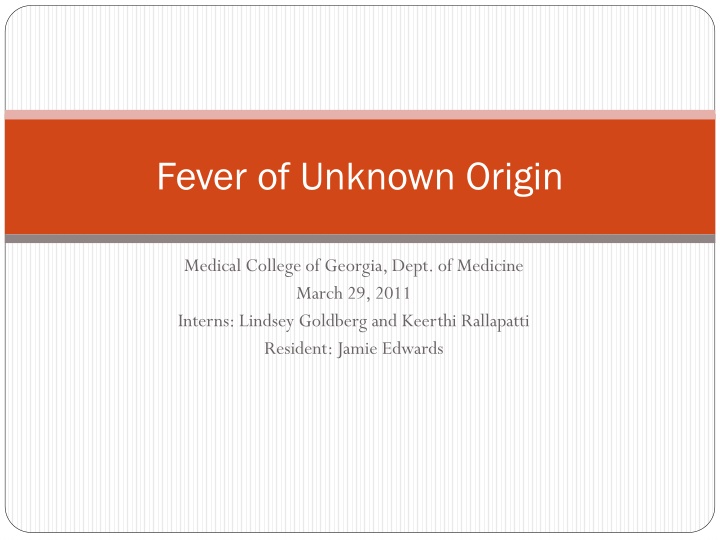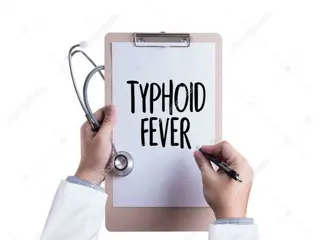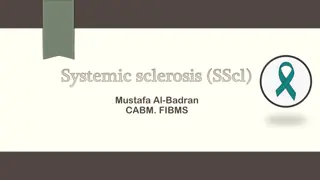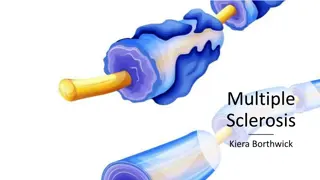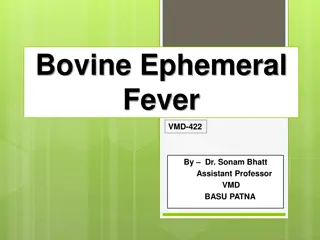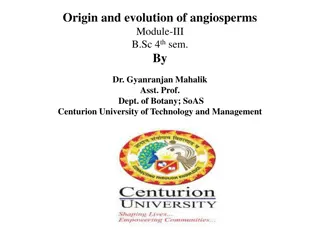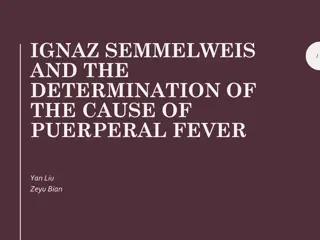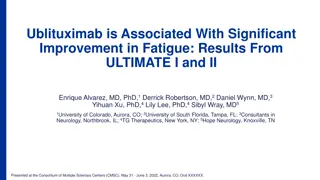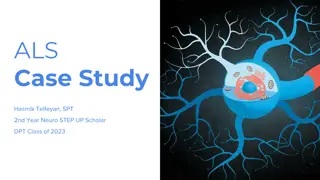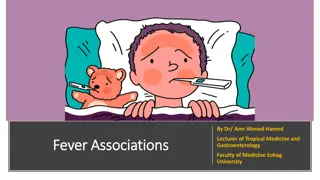Complex Case Study of Fever of Unknown Origin in a Patient with Multiple Sclerosis
A 42-year-old African American male with a history of Multiple Sclerosis presented with a fever of unknown origin, challenging the medical team to identify the underlying cause despite multiple investigations, treatments, and consultations. His complex medical history, including prior UTI treatment and recent antibiotic courses, adds layers of complexity to the case.
Download Presentation

Please find below an Image/Link to download the presentation.
The content on the website is provided AS IS for your information and personal use only. It may not be sold, licensed, or shared on other websites without obtaining consent from the author.If you encounter any issues during the download, it is possible that the publisher has removed the file from their server.
You are allowed to download the files provided on this website for personal or commercial use, subject to the condition that they are used lawfully. All files are the property of their respective owners.
The content on the website is provided AS IS for your information and personal use only. It may not be sold, licensed, or shared on other websites without obtaining consent from the author.
E N D
Presentation Transcript
Fever of Unknown Origin Medical College of Georgia, Dept. of Medicine March 29, 2011 Interns: Lindsey Goldberg and Keerthi Rallapatti Resident: Jamie Edwards
History of Present Illness: 42 y/o AAM presents as a transfer from Dublin VA with a chief complaint of FUO with a PMH significant for Multiple Sclerosis. He denies any cough, SOB, HA, CP, abdominal pain, diarrhea, dysuria, or any pain in general. He thinks he was transferred for a spinal tap. Hospital course at Dublin VA: Early February treated with IV Ciprofloxacin and Imipenem x1 week for UTI, then discharged home on PO Ciprofloxacin for Pseudomonas in urine sensitive to all abx tested and Augmentin for concerns of aspiration, although pt passed swallow study prior to discharge Readmitted 2 days later on 02/10/11 with fever, AMS and started on IV Ceftriaxone/Moxi, then on 02/16/11 changed to IV Vanc/Zosyn/Fluconazole/Cipro. He continued to spike intermittent fevers, but all cultures negative thus far. Then, repeat culture from 02/15/11 showed 1 out of 2 blood cultures positive for gram negative and gram positive organisms. Phone a Friend The ID Fellow at MCG was called and recommended to discontinue all IV antibiotics, and redraw new cultures. These were negative, and pt again spiked temperature, so they started him on IV Vanc/Zosyn/Cipro again 02/22/11. He was then transferred to VAMC DD for further work-up.
Continued History Past Medical History: Past Medical History: Past Surgical History: Past Surgical History: Craniotomy x2 at MCG Multiple Sclerosis Neurogenic bladder no indwelling catheter Seizure disorder DMII Decubitus ulcer, Stage I (Sacral)
More History Social History Social History Family History Family History Quit smoking tobacco in 1999 but did smoke ppd. Quit EtOH in 1999, denies current use. Denies illicit/IVDU. Married, lives at home with wife and 1 child. Home Health services Army Service 1991-1995. HTN Cancer Seizure disorder
Allergies: Allergies: Medications: Medications: Codeine Keppra 500mg BID Lisinopril 2.5mg Qdaily Omeprazole 20mg QPM Primidone 200mg TID Baclofen 20mg QID Gabapentin 300mg TID Interferon Beta-1A 44mcg/0.5ml SQ M/W/F
Physical Examination: Vital Signs: T: 36.7, HR: 108, BP: 142/73, RR: 20, Pox: 97% on RA Physical Exam: Gen: NAD, A&Ox3, multiple tremors and spasticity while talking HEENT: NC/AT, exotropia, no icterus CV: regular rhythm, S1/S2, no murmurs/rubs/gallops, no JVD Pulm: CTA-b/l, no w/r/r, non-labored Ext: no c/c/e, prevalon boots in place bilaterally, +spasticity and tremors especially of right arm, +peripheral IV at Right shoulder Neuro: A&Ox3, speech slowed and difficult, +spasticity, +tremors, able to squeeze left hand slightly Skin: Stage II sacral decubitus ulcer with pink granulation tissue, no discharge
Admission Labs and Imaging: WBC: 9.3, Hgb: 10.2, Hct: 30.7, Plt: 375 Na: 137, K: 3.9, Cl: 99.4, CO2: 25, BUN: 5, Cr: 0.6, Gluc: 93, Ca: 8.5, Mg: 1.9, Ph: 3.2, T prot: 7.1, Alb: 3.1, AST: 38, ALT:58, ALP: 59, T bili: 0.1 Coags: INR 1.70 VancTrough 15.7 UA negative EKG showed NSR Chest X-ray showed no pleural effusions, no signs of consolidation or infiltrate
Labs: Infectious work-up: Blood cultures and urine culture: No growth HIV negative HepA, Hep B, and Hep C nonreactive/negative RPR nonreactive Malaria smear negative (no malarial forms) PPD negative EBV results indicated past infection, not current infection CMV negative (<200) Serum Cryptococcus negative CRP elevated at 46.1 Non-infectious Inflammatory diseases (NIID) Rheumatologic work-up: ANA negative RF within normal limits (3.1) Anti-CCP negative (<8) CPK within normal limits (56) ESR within normal limits at 5 CRP elevated at 46.1 Endocrine: TSH and T4 within normal limits Malignancy: Hemoccult stool negative PSA not elevated Drug-induced fever: Discontinued all antibiotics on admission Did not restart Interferon
Fever of Unknown Origin: Historically term first used in 1961 By R.B. Petersdorf Definition: Temp >38.3 on several occasions Duration of >3 weeks Diagnosis that remains uncertain after 1 week of investigation Durack and Street suggested change in criteria in 1991 to an uncertain diagnosis after 3 outpatient visits or 3 inpatient days
Fever of Unknown Origin Classical vs. Non-classical FUO populations Spectrum of underlying disease differs from Classical FUO with more infectious, neoplastic, and drug-induced cases Prompt empirical antimicrobial therapy +/- antifungal and antiviral therapy, esp. in Neutropenic FUO Contrasts to typically using caution against empirical therapy in Classical FUO Classical FUO: Fever 38.3 on several occasions Duration 3 weeks Diagnosis uncertain after 3 days of inpatient investigation or 3 outpatient visits Non-classical includes Nosocomial FUO Fever 38.3 on several occasions and Duration 3 weeks Hospitalized patients with infection not present or incubating on admission Diagnosis uncertain after 3 days despite appropriate investigations, including at least 48H incubation of microbiological culture HIV-associated FUO Neutropenic FUO FUO: over 200 reported cases in literature Four diagnostic categories: Infections Non-infectious inflammatory diseases Malignancy Miscellaneous
Minimal Diagnostic Work-up History** Physical examination CBC and differential Blood film reviewed by hematopathologist CMP, LDH, bilirubin UA and microscopy Blood cultures and urine cultures Joints, pleura, ascites, or CSF if clinically indicated ANA and RF HIV Hepatitis serology CMV IgMAbs, heterophil antibody test Q-fever serology (if exposure risk factors exist) Chest X-ray
Further testing: Evidence Recommends: Evidence Recommends: Duke Criteria: Infective endocarditis (1-5% of FUO cases) Liver Biopsy: benefits outweigh risks Temporal Artery Biopsy: Two studies identified Temporal Arteritis 16% and 17% Especially elderly patients CT abdomen has high diagnostic yield Intra-abdominal abscesses Lymphoproliferative disorders Nuclear Imaging Technetium is tracer of choice Evidence Recommends Evidence Recommends Against the following: Against the following: Bone Marrow cultures in immunocompetent patients Diagnostic yield 0-2%
Spectrum of diseases: No diagnosis 19% Infection 28% Inflammatory diseases 21% Malignancies 17% Temporal Arteritis in the elderly 16-17% DVT 3%
Distribution of disease categories: Between 1961 and 1990: of 692 cases 34% infection 22.1% malignancy 12.5% non-infectious inflammatory diseases (NIID) 15% miscellaneous 15% undiagnosed From 1990 till present: Frequency of infections and malignancy decreased NIID and undiagnosed cases increased
Final Answer? Never forget a good history! Patient has history of recurrent DVTs and is on Coumadin Subtherapeutic INR on admission Started Heparin drip On Monday Lower Extremity Dopplers showed Acute, completely occlusive deep venous thrombosis of thebilateral lower extremities; involving the superficial femoral vein on the right, and the common femoral, superficial femoral, profunda femoral, greater saphenous veins on the left. Also, chronic, wall associated subtotal deep venous thrombosis within the distal left superficial femoral and popliteal veins. DVT as cause of FUO: Venous thrombosis can present with prolonged fever 3 series reported DVT as the cause of FUO in 2% to 6% of cases
References Knockaert DC, Vanderschueren S, Blockmans D. Fever of unknown origin in adults: 40 years on. J Intern Med. 2003;253:263-275. Mourad O, Palda V, Detsky AS. A comprehensive evidence-based approach to fever of unknown origin. Arch Intern Med. 2003;163:545-551 Zenone, T. Fever of unknown origin in adults: evaluation of 144 cases in a non-university hospital. Scand J Infect Dis 2006; 38:632. Knockaert, DC, Dujardin, KS, Bobbaers, HJ. Long-term follow-up of patients with undiagnosed fever of unknown origin. Arch Intern Med 1996; 156:618. Mackowiak, PA, LeMaistre, CF. Drug fever: a critical appraisal of conventional concepts. An analysis of 51 episodes in two Dallas hospitals and 97 episodes reported in the English literature. Ann Intern Med 1987; 106:728. Bleeker-Rovers, CP, Vos, FJ, de Kleijn, EM, et al. A prospective multicenter study on fever of unknown origin: the yield of a structured diagnostic protocol. Medicine (Baltimore) 2007; 86:26.
